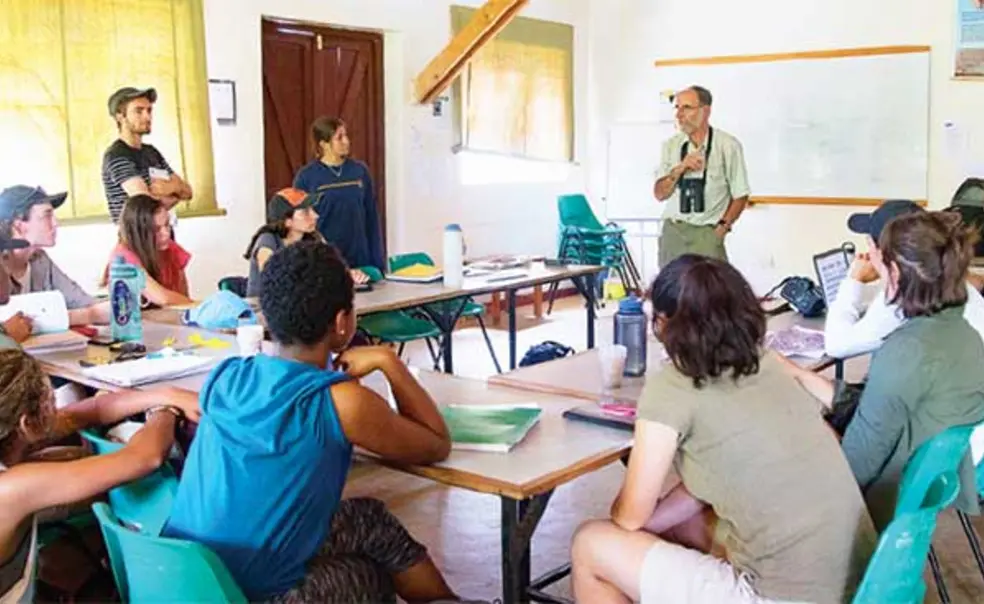The Mpala Research Centre: Celebrating 25 Years with a Powerful Vision for the Future
Just over 30 years ago, George Small ’43 contacted the University with an idea—he wondered whether Princeton would be interested in establishing a research center in Kenya, to be located on a ranch that George had inherited from his brother. Thanks to George’s vision and commitment, Princeton is simultaneously celebrating the 25th anniversary of the Mpala Research Centre (MRC) and taking on new management responsibilities for it.
While many Princetonians have helped to carry forward what George Small began, two deserve special mention. Dan Rubenstein, the Class of 1877 Professor of Zoology and professor of ecology and evolutionary biology and director of the Program in Environmental Studies, has been an extraordinary champion for Mpala from its inception. One of the foremost zebra experts in the world, Dan’s research on the endangered Grevy’s zebras at Mpala has transformed the understanding of the species, with critical implications for conservation efforts. His infectious commitment to the teaching and research possibilities at Mpala has inspired faculty members and students from a wide range of disciplines, and “citizen scientists” from around the world, to conduct research at the center.
Dennis Keller ’63 shares Dan’s passion for Mpala. Dennis worked shoulder-to-shoulder with George Small to make Mpala what it is today. For more than two decades, his leadership in stewarding the land on which the MRC sits for research, teaching, and conservation has been critical to enabling its success. His extraordinary contributions and collaborative efforts have positioned Mpala to continue to thrive in the longer term.
The MRC began as a joint project among several partners, including the Smithsonian Institution, the National Museums of Kenya, the Kenya Wildlife Service, the Mpala Wildlife Foundation, and Princeton. Just over three years ago, the University became the MRC’s managing partner. After much help and encouragement from Dennis Keller, extensive vetting by the Princeton administration, and thoughtful deliberation with the Board of Trustees, the University this year took on similar management responsibilities for the 48,000 acres of land that are home to the center and roamed by a dazzling array of wildlife, including precious populations of endangered African elephants, giraffes, lions, and zebras.
We think this venture is unique in higher education. Princeton rarely establishes a physical presence in another country, and the University has certainly never before assumed responsibility for a research center on a large tract of land (80 times the size of our campus) located 7,000 miles away from Nassau Hall. Why does Mpala deserve such special treatment?
First, the educational opportunities for our students are unparalleled. Undergraduates participating in the spring Semester in the Field program at Mpala, a program offered in partnership with Columbia University, delve into tropical biology and sustainability in a living laboratory that is completely different from anywhere they’ve ever been. Other undergraduates and graduate students from across the disciplines complete internships and independent research projects focused on conservation, ecology, biology, and anthropology, working alongside University faculty and Kenyan scientists. The seamless blending of teaching and research that is core to our mission is exemplified in the work taking place at Mpala.
Second, the diverse Mpala ecosystems—encompassing arid grasslands, vibrant woodlands, and hundreds upon hundreds of plant and animal species—enable University researchers and their collaborators to conduct long-term, large-scale controlled ecological experiments that are not possible at publicly managed conservation sites. This provides unique opportunities to explore a range of questions on topics that matter to the world. Research conducted at Mpala is contributing to critical conversations on topics ranging from climate change and biodiversity to public health, agriculture, and land use.
Third, through our increased engagement with the MRC, Princeton will be able to deepen its contributions to the world. We have opportunities to broaden the work of Princeton students and faculty focused on science and conservation and to expand the involvement of scholars in the humanities, social sciences, and engineering. We are also committed to enhancing Mpala’s connections with the local community in Laikipia County and strengthening collaborations with scientists in Kenya and throughout Africa. With support from the U.S. National Science Foundation, we have recently constructed a state-of-the-art genomics and stable isotope lab at Mpala, the first field-based lab of this kind in Africa.
Dino J. Martins, the executive director of Mpala and a lecturer and visiting research scholar in ecology and evolutionary biology, has described the vision for the future of Mpala as one “where we robustly engage in solving the problems that we face, whether in Africa or globally, by bringing the brilliance and passion and curiosity of students and scientists from around the world to really make a difference.”
It is a powerful vision, and we look forward to taking the necessary steps to realize it. Though we lost George Small in 2002, I am delighted that he had an opportunity to see Mpala begin to blossom in its early years. I cannot help but imagine that he would share my enthusiasm not only for what Mpala has become today, but also for its vast potential in the future.












No responses yet